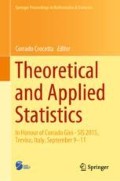Abstract
The process of minority segregation within global cities is a complex phenomenon. In the European urban context, the process of minority segregation seems to differ in the old immigration countries (France, UK, Netherlands, Germany) from the new immigration countries (Italy, Greece, Spain, Portugal). The analysis compares two global cities (Paris and Rome), taking into consideration the current evolution of the minority segregation pattern. The study shows that in both cities no traces of significant increasing segregation emerge over the last twenty years.
Access this chapter
Tax calculation will be finalised at checkout
Purchases are for personal use only
Notes
- 1.
The territory considered in this study is not limited to the municipalities of Paris and Rome alone, but extends further over what is defined as is the urban area. It is generally recognised that study of the residential inclusion of foreign populations cannot be limited to the core given the tendency of foreigners to settle also in the outlying areas. In the paper we use the definition of aire urbain for Paris, according to the official INSEE (Institut National de la Statistique et des Études Économiques) proposal. We create a metropolitan area for Rome, which includes the Rome municipality itself and three strata of contiguous municipalities. In sum 104 municipalities were included.
- 2.
The territorial grid used in the study includes IRIS in Paris, the Ilots Regroupés pour l’Information Statistique, a socio-spatial division equivalent to a census tract introduced by INSEE (see, for the definition, [8]). As far as Rome is concerned, we used two territorial grid levels: first, a macro one including the 122 urban zones - or toponomastic zones - in which the Rome municipality is subdivided plus the 103 municipalities surrounding Rome; second, a micro territorial grid including census blocks in which at least one resident is counted in census years.
- 3.
Considering the adjusted version of the Dissimilarity Index (for the sake of brevity not reported here), on checking for the random component of the territorial distribution (see [8]) no trace of increase emerges in the 1990–2007 years in the index constructed for Italians and Spanish immigrants (on the contrary, the index shows a decrease).
- 4.
- 5.
In fact it must be borne in mind that a substantial part of Maghreb origin population has acquired French citizenship in the past. In this case, it is possible that the rising degree of consistency between the geographical distribution of immigré from Maghreb and those of autochthones population (whether French citizenship was acquired at birth or not) is also caused by the presence of a significantly component of French citizens originated from Maghreb.
- 6.
«La ségrégation ne baisse que faiblement avec l’ancienneté de l’arrivée des immigrés en logement privé (… et …) les taux de ségrégation moyens ne diminuent que faiblement au fil du séjour en France pour les personnes vivant en logement social » [13: 188].
References
Barbagli M., Pisati M.: Dentro e fuori le mura. Città e gruppi sociali dal 1400 ad oggi. Bologna: Il Mulino (2012)
Bell, V.: A probabiliy model for the measurement of ecological segregation. Soc. Forces 43, 357–364 (1954)
Borjas G.J.: Ethnicity, neighborhoods, and human capital externalities. Am. Econ. Rev. 85, 365–390 (1995)
Casacchia, O., Natale, L., Martino, G.: La presenza straniera all’interno della città: Roma e Parigi a confronto. CISU, Roma (2012)
Echenique, F., Fryer Jr., R.G.: A measure of segregation based on social interactions. Q. J. Econ. 122(2), 441–485 (2007)
Heins, F., Strozza, S.: La geografia insediativa degli stranieri all’interno delle province italiane: differenze e determinanti. Studi Emigrazione 45(171), 573–601 (2008)
Massey D.S., Denton N.A.: The dimensions of residential segregation. Soc. Forces, 67, 281:315 (1988)
Pan Ké Shon J.L., Verdugo G.: Forty years if immigrant segregation in France: 1968–2007. How different is the new immigration? Urban Stud. 52(5), 823–840 (2015)
Park R., Burgess E. (eds.): The Urban Community. The University of Chicago Press, Chicago (1926)
Peach C.: London and New York: Contrasts in British and American models of segregation. Int. J. Popul. Geogr. 5, 319–351 (1999)
Poppe, W.: Patterns and meanings of housing: residential mobility and homeownership among former refugees. Urban Geogr. 34(2), 218–241 (2013)
Préteicelle, E.: La ségrégation ethno-sociale dans la métropole parisienne. Revue française de Sociologie 50(3), 489–515 (2009)
Verdugo, G.: Logement social et ségrégation résidentielle des immigrés en France, 1968–1999. Population-F 66(1), 171–196 (2011)
Verdugo, G.: Public Housing magnets: public housing supply and immigrants’ location choices. J. Econ. Geogr. 16(1), 237–265 (2016)
Author information
Authors and Affiliations
Corresponding author
Editor information
Editors and Affiliations
Rights and permissions
Copyright information
© 2019 Springer Nature Switzerland AG
About this paper
Cite this paper
Casacchia, O., Natale, L., Verdugo, G. (2019). Minority Segregation Processes in an Urban Context: A Comparison Between Paris and Rome. In: Crocetta, C. (eds) Theoretical and Applied Statistics. SIS 2015. Springer Proceedings in Mathematics & Statistics, vol 274. Springer, Cham. https://doi.org/10.1007/978-3-030-05420-5_9
Download citation
DOI: https://doi.org/10.1007/978-3-030-05420-5_9
Published:
Publisher Name: Springer, Cham
Print ISBN: 978-3-030-05419-9
Online ISBN: 978-3-030-05420-5
eBook Packages: Mathematics and StatisticsMathematics and Statistics (R0)

